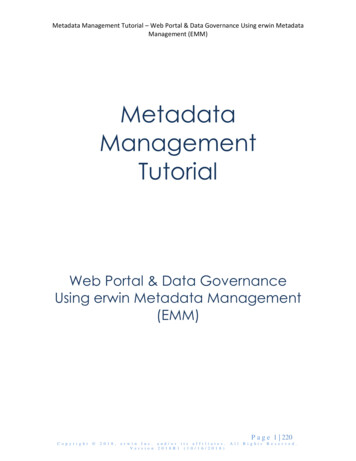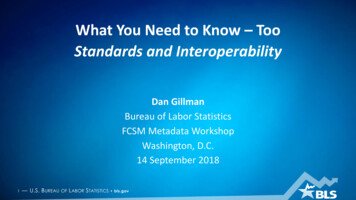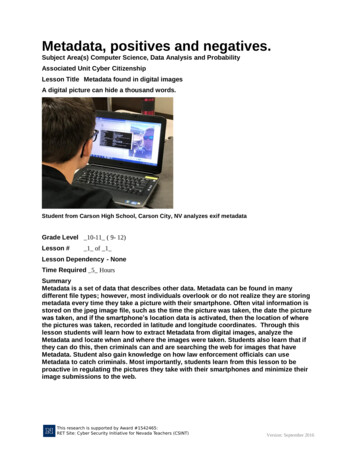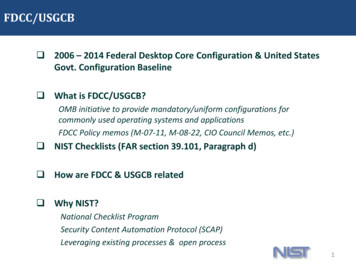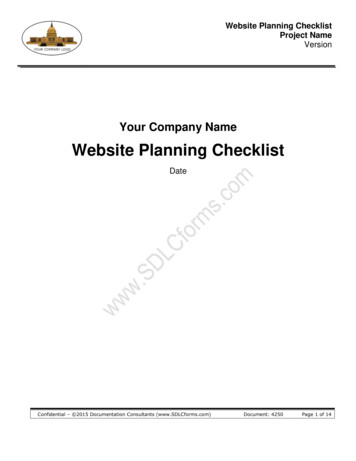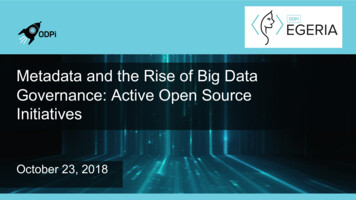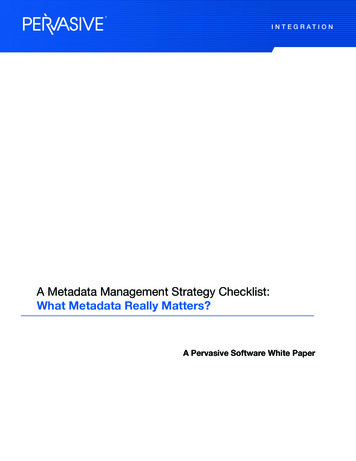
Transcription
I N T E G R AT I O NA Metadata Management Strategy Checklist:What Metadata Really Matters?A Pervasive Software White Paper
What Metadata Really Matters?The short answer is that all metadata matters. Not just the metadata about database schemas, butalso metadata about information processing flows, integration interfaces, data quality and on andon. Metadata is the key to providing answers to a great many questions, both for executive decisionmakers, and for IT professionals in the trenches who will be asking questions like: “If I buy this great new CRM application, how much is it going to cost my business to get ourprocesses switched over?” “What’s a realistic time estimate for getting customer, prospect, invoice and billing data stored infour different applications synced up to eliminate duplicate data entry?” “Will the labor and error-reduction savings justify the expenditure for the project?”Metadata is the essential blueprint for what data a company has, what it means and where theycan get it. Without clear accessible metadata, an enterprise could have all the data they need tomake sound decisions sitting on their servers and hard drives, and still end up making a best guessbecause they can’t find that data or making decisions that they later regret because they only founda fraction of the data they really needed, or couldn’t make sense of what they had.The trouble is, there’s been a lot of talk for quite a while now about the need for and value of creatinga warehouse for metadata that makes this critical information easily accessible, but businesses havespent too much money and seen far too little resultsTraditional Approaches Add to Your ChallengeTraditional approaches to metadata management have been ad hoc at best. Simple oral knowledgetransfer was not uncommon. In the past, database administrators or IT professionals would abstractmetadata from data sources by hand, using Excel spreadsheets or even doc files to document dataproperties and relationships. This type of documentation wasn’t exactly designed for answeringqueries, and locating these documents could be a challenge in itself since their location wasgenerally undocumented. But, the biggest shortcoming of this pile-of-documents approach wasthat it had no strategy for dealing with the natural drift and change of data structures, value sets andrelationships. Even assuming that the Excel spreadsheets or docs were accurate in the beginning,they would become increasingly inaccurate over time. It would be rare for overworked databaseadministrators to consider it their job to keep all of those scattered spreadsheets up to date.The other option was to pay a million dollars or so to a consulting company or tool vendor foran ambitious multiyear project. For large sums of money, a vendor would cheerfully build a slickmetadata repository with a great interface that provided a sharp, clear window into some fractionof the essential metadata that you had two years ago. Not quite what you need to make dynamic,adaptive decisions for this year, or this quarter.More Recent Approaches Have Led to Silos and InconsistencyNow that we have begun to move out of the dark ages of metadata management, various toolvendors across the enterprise are attempting to solve the metadata puzzle by storing the metadatathat is relevant to the type of problem that tool is designed to solve. This is definitely a step inthe right direction, but it’s far from ideal. Multiple isolated silos of metadata create redundancy,inconsistency, and incompleteness of metadata across the enterprise. The matter is complicated bythe sheer volume of data regularly processed in businesses today and the exponentially increasingnumber of new data and metadata sources.What MetaData Really Matters?2
In one place, data profiling and quality tools store statistics about the anomalies in the data, valueranges and other valuable information. In another, integration tools store design-time informationabout source and target data structures, transformation lineage, business rules and definitionsand process flow as well as run time information about production lineage, which versions wereexecuted, and success, failure and error logs. In still other locations, database managementsystems—either stand-alone or embedded in various applications—store field rules, names, types,and table structures, relationships and interdependencies. Each tool stores metadata in its ownproprietary format. And of course, there are still many applications that don’t store their metadata asan entity at all, and require metadata to be extrapolated either by hand or by custom coding.If an important big picture inquiry or an in-depth technical question requires more than one of thesetypes of metadata, there is no common place to go for the information. The information is scatteredacross multiple metadata repositories in multiple locations—and multiple storage methods—rendering the accessibility of cross-functional metadata an unavailable option. On top of that, thesetools and metadata storage mediums are part of the constantly changing business landscape. Intoday’s world of continual mergers and acquisitions, changing business initiatives, and constantlyincreasing variety of applications, sources of both data and metadata are unstable, moving targets.The one lesson that both the hand documentation and the overpriced, insufficient metadatasolutions of the past teach us is that capturing metadata—while it may seem like a daunting task—isrelatively easy. Modern tools have made that aspect of the job even easier. Achieving a unified viewof all metadata across the enterprise without bankrupting the company, and keeping that metadatasynchronized with the actual properties of the data sources, are the real challenges.Metadata Management Strategy ChecklistThe secret to meeting those challenges is to build the metadata solution on top of a versatileintegration platform that exposes its own metadata for consolidation, automatically extrapolatesmetadata from sources that don’t provide it, and provides the connectivity capability to extractmetadata from a wide variety of data sources. Modern integration toolsets frequently includemetadata management capabilities as part of the package. Since a good metadata strategyrequires bringing together a huge variety of disparate data sources and since a fair number of thebenefits of metadata management are directly related to data and application integration projects, itmakes sense to not just build the metadata warehouse with integration processes, but to build themetadata management into the warehouse and processes.1. Consolidate Metadata - The first step in a good overall metadata strategy is to extract themetadata out of its isolated silos and bring it all together. This will reduce data redundancy,duplication and inconsistencies. This is, in its essence, an exact-transformation-load (ETL)problem; using a good ETL tool to get the metadata out of various repositories, cleanse andaggregate it and load it into a metadata warehouse makes perfect sense.2. Automate Synchronization – A scheduled or change-event driven automated integrationprocess can make certain that the metadata warehouse is regularly updated and will remainsynchronized over time with the changing sources, without adding to anyone’s ongoingworkload. In addition, when future data sources are added, with an integration toolset that has adecent user interface, it’s a simple matter to extend already established integration processes toinclude new data sources.What MetaData Really Matters?3
3. Make ALL Enterprise Metadata Easily Searchable - A comprehensive metadata warehousewith a well-documented star schema or other query optimized structure, can make a world ofdifference in terms of the speed and quality of answer. The data warehouse should be designedfor optimal use with your existing or desired business intelligence (BI) reporting tools, but not belimited to only BI-related metadata. It should enable you to retrieve all the metadata that mattersto everyone across the enterprise, whether business or technical, front office or back office,into a single location, and then provide multiple windows into that data. This will provide a clearglobal view of the enterprise and enable knowledge transfer and information sharing. It alsomeans that the metadata that matters to any particular user will be easy to find when needed.You will be able to find answers to technical, business, or cross-boundary issues that haven’teven been conceived of yet in a good metadata warehouse.4. Get your ROI perspective in shape - So, you’ve got a good idea of how to build an enterprisewide robust metadata management strategy. The question now is, “Why bother?” It’s toughto show the ROI for metadata initiatives in hard numbers up front, especially since a lot of thebenefits show up over a fairly significant length of time. It’s essential to have a low-cost optionthat makes ROI a no-brainer. A low cost point can make the difference between months ofjustification, and a low effort, back-of-an-envelope kind of calculation. Start tactically. Build asmall, viable data warehouse that includes just the information for a particular business segment,such as a division or department. This allows the demonstration of clear ROI with low risk. It alsogives you a chance to build model integration and synchronization processes that can then bere-used or extended to other departments, at an even lower cost.A solid metadata strategy can show a clear increase in ROI and decrease in cost point for a varietyof other important initiatives as well. For instance, it can help to show adherence to data governanceand compliance requirements by providing a clear audit trail.Benefits of Robust Metadata ManagementMetadata management is critical for organizations that rely on multiple data sources for businessintelligence, especially if some of those data sources are older, or less easily accessible. Includingeven hard-to-get metadata improves the knowledge base available for BI queries, giving morerelevant, accurate and useful analyses and reporting. The ability to view and analyze both technicaland business metadata also provides a mechanism that ensures that the value being extracted fromthe data continues to meet business objectives. This can improve IT decision-making by validatingtechnical processes with business goals.For integration projects, metadata provides data lineage throughout various stages of transformationfor future error checking, compliance auditing, and data quality improvements. Good metadata canhelp with any business policy or infrastructure change by providing information that helps companiesgauge the complexity of changes and plan the best use of resources. This can significantly reducedevelopment and maintenance costs. Management of integration design metadata can also providethe basis for module re-use. Enabling collaboration and component re-use significantly acceleratesproject timelines. The creative use of metadata can provide innovative approaches to long-standingintegration problems that provide completely unforeseen benefits. A good example is the VisionAward-winning process of LifeMasters Supported SelfCare, Inc. Using metadata on top of a versatiledata integration platform, LifeMasters was able to reduce patient data processing time from fivedays to two hours, and new patient on-ramping from 7-10 days down to 1-2 days.(http://www.prweb.com/releases/LifeMasters Vision Award/Business Impact/prweb1531744.htm)What MetaData Really Matters?4
Overall, the goal of a metadata management strategy is to reduce IT costs and increase corporateproductivity and agility, and that always translates one way or another to increased ROI. With asolid, broad-spectrum, easily searchable metadata warehouse and automated updating processesin place to keep it current, an enterprise will undoubtedly see benefits, including those theorganization may not have thought of. Executives, data analysts and developers will also genuinelyunderstand their data descriptions, definitions, lineage and relationships. The metadata that reallymatters will be at their fingertips.What MetaData Really Matters?5
. What our customers are sayingÆLZ ]VY bVcn YViV [ZZYh VcY YViV ineZh i]Vi cZZYZY id WZ fj X an beaZbZciZY c dgYZg id WZ VWaZ id VhhZhh djg dkZgVaa edgi[da dÉh VY]ZgZcXZ id g h ZmedhjgZ \j YZa cZh# 8jhidb XdYZ XdjaYcÉi bZZi djg cZZY id fj X an \Zi eda Xn YViV cid djg YViV lVgZ]djhZ VcY VcVanhihÉ ]VcYh# EZgkVh kZ ciZ\gVi dc \ kZh jh Xdhi"Z[[ZXi kZ! l YZ"hXVaZ XdccZXi k in i]Vi XdbeaZbZcih djg bdkZ id hjeedgi \gZViZg VjidbVi dc VcY VcVanh h#Ç7dZh[m M bZ Head of ITScottish Re Holding LimitedÆEZgkVh kZÉh hd[ilVgZ ]Vh VaadlZY :adfjV id [dXjh dc djg Zn kVajZ egdedh i dc l i]dji ]Vk c\ id YZkZade Xjhidb XdYZ! hd i]Vi lZ XVc Wg c\ je cZl XjhidbZgh l i] XdbeaZiZ 8GB ciZ\gVi dc c V [gVXi dc d[ i]Z i bZ [dgbZgan gZfj gZY# I]Z ciZ\gVi dc V\Zci h V kZgn ZaZ\Vci hdaji dc [dg gZVX] c\ aZ\VXn Veea XVi dch WZ] cY i]Z [ gZlVaa#ÇIj[l[d MeeZiChief Technology Officer and Co-founderEloquaÆEZgkVh kZ ]Vh ]ZaeZY jh bdkZ [gdb bVcjVa YViV XdckZgh dc id V fj X "] ii c\ ZbWZYYZY hd[ilVgZ hdaji dc! VcY cZmi hZZ 6h Zh h jh c\ EZgkVh kZÉh ciZ\gVi dc Zc\ cZh c ]Zae c\ jh VjidbViZ [dgbVii c\ VcY Xdbea VcXZ egdXZhhZh#Ç:[l[dZhW HWeVice President, DevelopmentAskesisÆEZgkVh kZ 9ViV ciZ\gVidg h cdl [jaan ZbeadnZY! gZVaan cVggdl c\ i]Z i bZ l cYdl ldjaY ]VkZ [djcY c V WVX "dji Xjhidb"XdYZ gZWj aY# 8dhi"l hZ! EZgkVh kZ ]Vh hVkZY jh h \c [ XVci djiaVnh# LZ hVkZY c l]Vi lZ eV Y Vc d[[h]dgZ kZcYdg id lg iZ VcY bV ciV c XdYZ! i]Z Xdhih VhhdX ViZY l i] XdggZXi c\ YViV i]Vi lVh bVc\aZY Wn WVY XdYZ! VcY i]Z Xdhih VhhdX ViZY l i] YZaVn c\ YViV igVch[Zgh Wn jh c\ EZgkVh kZ dkZg Xjhidb XdYZ#Ç8 bb I[WoDirector of ITRevenue Recovery CorporationÆL i] i]Z EgdXZhh 9Zh \cZg ZbWZYYZY l i] c EZgkVh kZ 9ViV ciZ\gVidg! lZ ]VkZ gZYjXZY i]Z egdXZhh c\ hiZeh [gdb ,* id dcan # EgZk djhan l i] i] h XjhidbZg! [ lZ lVciZY id X]Vc\Z V [ aZ[dgbVi! lZ ]VY id bVcjVaan X]Vc\Z i c ,* Y [[ZgZci eaVXZh# I]Z EgdXZhh 9Zh \cZg ZcVWaZh jh id bV Z X]Vc\Zh c dcan dcZ eaVXZ# Jh c\ EZgkVh kZ 9ViV ciZ\gVidg! lZ ]VkZ gZYjXZY djg bV ciZcVcXZ i bZh Wn bdgZ i]Vc ]Va[ VcY i]Z XjhidbZg gZXZ kZh bdgZ jhVWaZ YViV bjX] [VhiZg VcY l i] [Vg aZhh g h d[ Zggdg#Ç@Wo hWl[iPresidentSmartDMÆEZgkVh kZ ]Vh ZcVWaZY jh id [Vg hjgeVhh djg Zm hi c\ YViV \Vi]Zg c\ XVeVW a i Zh# EZgkVh kZ 9ViV ciZ\gVidg d[[Zgh dji"d["i]Z"Wdm XdccZXi k in VcY chiVcian begdkZh egdYjXi k in! l] X] Y gZXian WZcZ[ ih ]dhe iVah VcY i]Z g eVi Zcih#ÇA[l d 9edmWoVice President of Health InformationNebraska Hospital AssociationWhat MetaData Really Matters?6
ÆEZgkVh kZ hd[ilVgZ Za b cViZh i]Z cZZY [dg djg YZkZadeZgh id heZcY i bZ bVcjVaan XdY c\ VcY gZXdY c\ ZVX] YViV igVch[dgbVi dc VcY lg i c\ Veea XVi dch id bdkZ YViV# chiZVY! YZkZadeZgh XVc XgZViZ VcY gZjhZ V h c\aZ bVe i]Vi XVc WZ b c bVaan bdY [ ZY [dg hZeVgViZ igVch[dgbVi dch# DcXZ i]Zdg \ cVa bVe h YZkZadeZY! i]Z bV dg in d[ i]Z YViV igVch[Zgh l aa WZ VjidbViZY! hVk c\ jh ]jcYgZYh d[ ]djgh d[ XdY c\ VcY lg i c\#Ç:Wl Z CYCWj Database Administrator and Software EngineerPayment Processing, Inc.Æ XVc hVn i]Vi EZgkVh kZ VaadlZY jh id VX] ZkZ gZhjaih c Xdch YZgVWan aZhh i bZ i]Vc i ldjaY ]VkZ iV Zc id Wj aY djg dlc ciZ\gVi dc Zc\ cZ# I]Z Xdhi d[ EZgkVh kZÉh hdaji dc h [Vg aZhh i]Vc l]Vi i ldjaY ]VkZ Xdhi jh id Wj aY VcY bV ciV c djg dlc#Ç 9bW h[ 7dd[Y dChief Information OfficerMEDecision, Inc.ÆLZ Xdch YZgZY hZkZgVa iddah [dg YViV igVch[dgbVi dc VcY hdbZ lZgZ Vh c\ ,%!%%% id &%%!%%% id Yd V h beaZ XdckZgh dc# LZ add ZY Vi i]Z [jcXi dcVa in EZgkVh kZ XdjaY egdk YZ [dg V adlZg eg XZ VcY i]Z YZX h dc lVh ZVhn# EZgkVh kZ hjeedgih bVcn Y [[ZgZci [dgbVih VcY l i] i]Z bZg\ c\ d[ Y [[ZgZci hnhiZbh! i]Vi kZghVi a in ]Vh WZZc kZgn kVajVWaZ [dg jh!Ç J[Z IWX deSenior Network ConsultantNorthrop GrummanÆ add ZY [dg Vc ciZ\gVi dc hdaji dc i]Vi ldjaY \ kZ i]Z XdbeVcn ZmVXian l]Vi EZgkVh kZ egdk YZY/ Y gZXi XdccZXi k in id cjbZgdjh aZ\VXn hnhiZbh! ZmiZch kZ bVee c\ XVeVW a in VcY [Vhi egdXZhh c\# c iZgbh d[ kVajZ! i]ZgZ lVh cd XdbeVg hdc#ÇF[j[h CkhZeYaSenior Database DesignerAEGON Equity GroupWhat MetaData Really Matters?7
Contact InformationPervasive Software Inc.12365 Riata Trace Parkway, Building IIAustin, Texas 78727http://www.pervasivedataintegration.comUnited States888.296.5969512.231.6000Fax: eToll Free: 00800.1212.3434Phone: 0032.2290.5391Fax: 0032.2.709.7883integration@pervasive.com '%%. EZgkVh kZ Hd[ilVgZ cX# 6aa g \]ih gZhZgkZY# 6aa EZgkVh kZ WgVcY VcY egdYjXi cVbZh VgZ igVYZbVg h dg gZ\ hiZgZY igVYZbVg h d[ EZgkVh kZ Hd[ilVgZ cX# c i]Z Jc iZY HiViZh VcY di]Zg Xdjcig Zh# 6aa di]Zg bVg h VgZ i]Z egdeZgin d[ i]Z g gZheZXi kZ dlcZgh#What MetaData Really Matters?8
Metadata management is critical for organizations that rely on multiple data sources for business intelligence, especially if some of those data sources are older, or less easily accessible. Including even hard-to-get metadata improves the knowledge base available for BI queries, giving more relevant, accurate and useful analyses and reporting.
